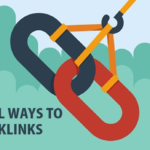Can you name one business or brand that doesn’t have a strong online presence?
There is probably no such brand!
Most 21st century customers’ first introduction happens when they discover the business online.
So, bringing your business online is a sheer necessity and no longer a personal choice.
Still not convinced why you need to focus on building an online presence?
A strong online presence can place your business in front of your target audience.
97% of customers search online for local services and products, so having an online presence can increase your reputation and build brand awareness.
It can help customers find your brand and help them learn about your reputation before making a purchase decision.
If you’re a brand looking to make a lasting impact on your customers, focus on building a strong online presence.
8 Online Solutions to Build Your Business Presence
Here are eight ways you can follow to build your online presence:
- Give a personal touch using business cards
A business card is something that digital can never replace. Though they are touted as an old-school thought for offline marketing, business cards are a significant portion of the branding strategies marketers use to beat their competition.
These business cards don’t merely hold contact details such as email, name, or phone number; they’re the best way to create a positive first impression.
But, how can business cards help in building a robust online presence?
Today, a modern business card works like a direct marketing tool.
If your brand has a website or online presence, you can include a link to your social media pages on your business card. You can even list a readable URL of the landing page. This landing page can help you attract potential customers.
While it’s essential to integrate your business cards with your online marketing tactics, focus on the quality of these cards. The personal warmth in sharing business cards is essential because it reminds the customer of your professionalism.
Also, when you have a high-quality business card, customers are more likely to refer your brand to others because you come across as a professional business.
This ensures that your website’s landing page link reaches a larger audience and more customers visit your website.
- Perform SEO with the latest updates
With only 49% of small businesses investing in SEO, SEO is a free way to get on the first page of Google’s ranking.
Though SEO efforts might take time, they deliver the intended result. Investing in your SEO efforts is essential because it’s a stock that will pay long-life dividends.
Start your efforts by leveraging the Google Trends API for identifying relevant and trending keywords, in addition to following the tried and tested methods like optimizing images and building high-quality relevant links. This is an effective strategy that yields desired SEO results in the long run.
Another worthwhile SEO strategy is using schema markup. This ensures that rich snippets appear below your site title in the SERP. With pandemics forcing customers to purchase online, a local SEO ranking can differentiate your business from others.
By ranking on the first page of Google, your business can receive the required online presence and ensure you have a constant flow of visitors to your website.
- Limit your presence to platforms you can handle
When building an online presence, remember that it’s more about quality than quantity. So, choose only those platforms where you might find your customers. Having two to three accounts with solid engagement is much better than having several accounts with weak or no activity. Some platforms to consider are:
- YouTube
- Snapchat
- TikTok
- Snapchat
Also, choose a platform based on your industry. Companies in specific industries can excel on Facebook while others benefit from Instagram or TikTok. Before choosing a platform, conduct market research to understand the likes and dislikes of your customers.
Additionally, you can use Facebook to build relationships, Twitter for public relationships, YouTube for lead generation and brand awareness, and TikTok to build relationships and increase conversations.
- Personify your brand
Creating an online presence is time-consuming and requires significant effort. You cannot build an online presence in one day.
One great way of increasing online presence is personifying your brand. This projective technique allows people to consider a brand as an individual and describe how these brands feel and think.
When you personify your brand, you can designate human qualities to the brand. This helps you connect with customers at a personal level.
Like human relationships, this personal connection results in a loyal customer.
For example, a daily newsletter called The Skimm used personification to create a persona ‘The Skimm Girl.’ The company knew the girl’s like, disklike, financial situation, job, and age.
- Think above blogging
Maintaining and regularly updating a blog can increase your online presence. But, for defining your brand’s voice and building trust, you need to create meaningful and informative content.
However, what’s the point in limiting yourself to just creating a weekly blog post?
Over a period of time, customers are likely to lose interest because you share the same type of content.
According to a report, 60% of marketing professionals think of case studies, and research as the content their audience finds trustworthy.
So, focus on developing multiple forms of content to keep your customers engaged. Focus on:
- Creating infographics
- Publishing eBook and whitepaper
- Building a client’s case study
- Hosting a live podcast
- Creating and conducting an online course, webinar, workshop, and seminar
You can build a solid online presence and effortlessly reach your target audience when you go beyond blogging.
- Claim your profile on local directories
Even if you’re growing your company into international markets, creating profiles on local directories can help your business scale up. When your business is present on the local directories, people can access information without visiting your website.
When customers search for a local salon shop, they’re likely to use Google’s local directory called Google My Business. Using this local directory, customers can explore and compare various options. Rather than going back-and-forth between each salon’s site, they can view the information on a single page.
While you might prefer customers to visit your website, that’s not always what customers do.
What’s more interesting about local directories is that they can significantly improve your brand’s online presence. Apart from listing all businesses in one place, local directories benefit from review management and SEO.
When creating a profile on these directories, focus on providing your complete business name, address, and phone number. Give information on your working hours and closures. Remember to upload videos and photos of your location and products.
Focus on responding to customer reviews, questions, and comments to engage customers and build a strong online presence.
Unlike other methods mentioned on this list, managing local directories requires more proactive management.
- Use responsive website design
Creating a functional website is one thing while ensuring a responsive website design is another. A responsive design is more than a necessity. Why?
94% of customers leave a website that is difficult to navigate.
That’s why responsive design is the next big thing in the web design field. A responsive design works as your go-getter because it makes your website mobile-friendly and improves how it looks on large and small devices.
A responsive website design can increase a customer’s time on your website. This can help in improving your search engine rankings.
Designing a responsive website involves avoiding unnecessary scrolling, zooming, resizing, and panning. The absence of these elements can make your site slow and even cost you your potential customers.
Today, responsive website design can replace dedicated mobile websites. Instead of designing multiple websites for smartphone users, you can create just one responsive website design that scales down based on the screen size.
- Consider online advertising
One leading way to increase the impact of your online presence is purchasing online advertising. You can use the pay-per-click (PPC) model or Google AdWords.
In a PPC model, you place bids on relevant keywords for an ad. When potential customers click on your ad, you pay an amount set by the bid. Though PPC is an expensive advertising model, it can increase your online presence by manifolds.
Whether you’re an online business or have a physical store, consider investing in PPC ads and working with a PPC agency for eCommerce, which will help to increase your sales.
With substantial investment, brands can reach their target audience, spread the word about their business, and increase their online presence.
Tips to remember
With the online landscape changing rapidly, businesses can longer ignore their online presence.
Every business model is different, and every brand is unique. To grow your online presence, the strategies you follow should reflect your business requirement.
Though these are just tips to get started on your journey for increasing your online presence, you might need to alter a few of them based on your business’s requirements.
Having a strong online presence allows your business to get discovered by new customers and the more touchpoints you have with your audience.




